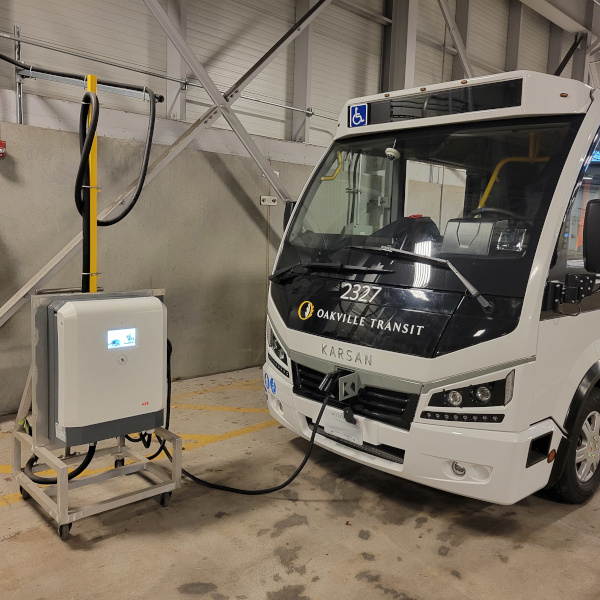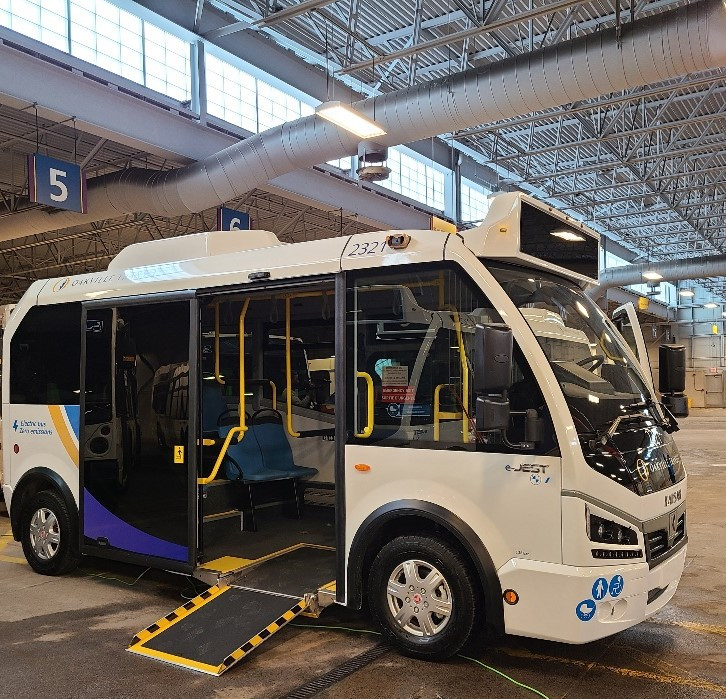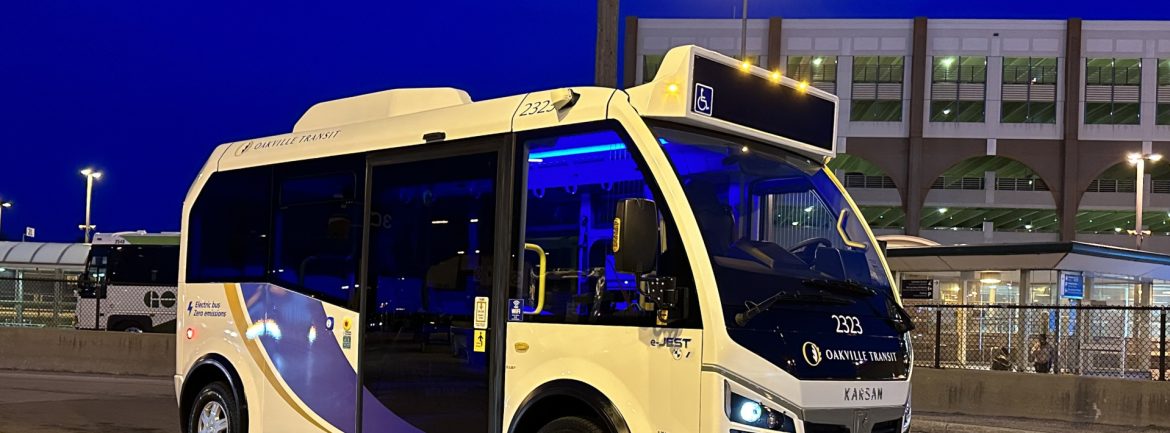Oakville Transit
Oakville Transit: Seeking ways to increase ridership
Municipal provider welcomes the transition into electric transportation
Since 1972, Oakville Transit has been the public transportation provider in Oakville, Ontario, a suburb of the Greater Toronto/Hamilton Area (GTHA), with a population of over 200,000. The system operates a fleet of 101 conventional buses that provide service on 22 fixed routes and eight school specials. It also operates 24 small-capacity transit vehicles for specialized and on-demand services.
The Oakville Transit network provides service within the town of Oakville, as well as making connections to neighboring municipalities – the city of Burlington and the city of Mississauga. Since it is located about a half-hour drive from Toronto, it is also a preferred means of transportation to and from that bigger city. It provides direct connections to the regional rail network, also known as GO Transit, and services the six GO Transit stations, which have a mixture of rail and bus operations.
Recovering from the pandemic
When COVID hit, the system was severely impacted as lockdowns and travel restrictions caused a major reduction in ridership. But according to Director of Transit, Adrian Kawun, those pre-pandemic levels are close to returning. “On some days, we’re seeing more ridership than we did in 2019,” he says.
“That also is an effect of some of the programs that we put into place for residents to come back to transit and how we promoted the use of public transit over the personal car to get to destinations around and throughout the town.”
One of those promotional programs, instituted this past spring, included extending free transit to young people and seniors in the town. “We were trying to get our youth onto the system; to get them to know how to use the system and have that usage continue through their adult lives,” Kawun reports.
“Once we implemented free transit, the explosion of ridership was amazing — and from not only youth and seniors. We had to put more service onto the street just to accommodate the additional rides.”
Communication with riders is key
Kawun has been in his present position for the past two years, having logged over 16 years in the transit industry as a vehicle cleaner, revenue collector, transit scheduler, service planner, and planning manager. He believes that a lot of people don’t use public transportation because they don’t understand how well it can work for them. “And to get people on, you have to teach them,” he says. “You have to provide those communications in terms of how, what, when, and where.”
To achieve that necessary level of communication, Oakville Transit relies on a full suite of technological platforms, starting with its Intelligent Transportation System (ITS). “Our ITS system helps us identify where all the buses are in the system, and helps us to dispatch and locate the vehicles throughout the entire network,” Kawun explains.
“The ITS system that we have on the street also is fed into our scheduling information, so we know, and it can predict, where the buses should be. And that is relayed into ITS’ real-time customer apps. Customers can see where buses are throughout the network, via the internet, via text messaging, and through the app that we have for Oakville Transit.”
“This information does help passengers understand, especially on the lower frequency routes, if the bus is running on time, or if it’s delayed by whatever means,” Kawun continues. “Our stops all have a four-digit code which could be texted to our ITS system and a text gets sent back saying ‘your bus will be at your stop at this time.’ That information helps people understand where the buses are. So, they know what to expect. And that expectation and knowledge do promote usage because people are not standing at the stop wondering.”
“We also have automatic passenger counters on our buses. These counters tell us how many passengers get on and off the system at any stop location. That helps to promote where and when we insert service. We like to make sure that we are providing enough service for the demand of customers and having this ACE (Automatic Counting Equipment) system identifies where we are. If we see crowding issues, we can help customers have a more comfortable ride by inserting more service at those locations.”
 Comfort and security
Comfort and security
That attention to customer comfort extends to how riders can pay their fares.
“We have an electric tap-on/tap-off fare system,” Kawun notes. “It’s used by many of the transit agencies in the GTHA, so there is seamless integration and transferring done with the card. We also have implemented debit/credit open payment. So, anyone coming into the system who may not have a card, or maybe visiting Oakville, can just take out their credit card and tap on to take a trip with our system. That is very attractive to the customers, and we’ve seen a large uptake in terms of transit about the electronic fare payment and open payment system.”
“Last year we installed Wi-Fi on our buses, so customers traveling on the system could continue doing their work, or connect with family or friends while on their journey. We also have onboard video cameras that collect voice and video – that is primarily for the safety of our customers and our operators. Those systems come in quite handy when there is an accident or if a customer would like to recall an incident on the vehicle. So, we have quite an abundant ITS infrastructure that helps us operate the system, but also provides customer convenience while using, and trying to understand how to use our system.”
Going electric
Like many municipal transit systems across the U.S. and Canada, Oakville Transit is cognizant of the danger to public health caused by the emissions from its diesel and gas-powered buses. So, it is beginning to make the transition to electric transportation. With the help of funding from the federal and provincial governments, and the support of the Oakville town council, it recently purchased 15 small battery electric buses, which are primarily used for its specialized and on-demand type services. And it is planning to purchase an additional 15 conventional, 40-foot electric vehicles by the end of next year.
The switch from fossil fuels to electricity, while welcome, is a challenging one, as the agency now has to figure out how the new battery-electric vehicles are going to be powered. “This became a learning opportunity for us,” Kawun recounts, “because when you think about the number of buses that you’re purchasing as part of your fleet, you also have to start understanding the capacity of the building and the infrastructure required to electrify these vehicles.”
“Oakville Transit and the town of Oakville had to assess our garage facility to understand what the existing capacity to provide electricity to these buses was, and what we might have to upgrade in terms of the electricity coming into the site to power these vehicles, or recharge them when coming in from service on any given day.”
One thing learned was that the amount of electricity coming into the bus garage needed to be increased; all electrical feeds would have to be upsized. “But we’re transit operators and not electricians,” Kawun offers.
“So, we partnered with PowerON Energy Solutions. They are the ones who are helping us design our facility and they will be the ones building out the facility and electrifying it. Partnerships are key when you come to these types of massive capital projects; no one alone can implement them because there are so many variables in understanding what you’re going from – in our case, a diesel and gas propulsion system in our fleet, to, now, a mix of diesel, gas, and electricity, and eventually the plan is to go 100% electric.”
“There is a huge transition period that is required; you’re going to have to operate both systems at the same time. We’re pretty proficient with diesel, but we have to learn how to do it with electricity. So, partnerships are key; they help you understand what to look out for, what’s in the market, what is the best way forward, and any efficiencies that can be found in one: creating a solution that can be worked on, and two: implementing it,” he elaborates.
“It’s an interesting partnership because when you get to the level of major power generation and provide it for a fleet of buses, there are all sorts of items that need to be addressed. The main question is: how are you charging the bus? Is it a plug-in? Is it a pantograph that comes from the ceiling? (A pantograph is an apparatus mounted on the roof of an electric train, tram, or electric bus to collect power through contact with an overhead line.) What type of infrastructure is required to support and hold all that in place and then run all the lines?”
“PowerON is good at all that and this is why we partnered with them; they know how to do it; they’ve got the people and the expertise in being able to provide a solution so that we can focus on our primary target of providing transit service to our customers.”
“That being said, we’re also implementing charging stations at our terminals and some of our community centers to help begin creating a network of charging opportunities throughout the town. The town, itself, is also implementing charging stations; they’ve already implemented 23 electric charging stations on streets and in town facilities, which will help promote electrification, not only for municipal fleet transit but also personal vehicles for anyone who chooses to purchase an electric vehicle in the town of Oakville.”
 Partnering with the private sector
Partnering with the private sector
Building successful partnerships, according to Kawun, also extends to Oakville’s business community. “We try to partner with companies throughout the town where we can provide shuttle services to and from major trip generators,” he relates.
“For example, we are in discussions with a major company where the majority of their staff would be taking the regional rail network and then transferring onto a shuttle service to take them to their final destination. What this does is one: it reduces the amount of vehicles coming onto and off of the property, and two: it helps employees get to and from work on time. One partnership we just completed is between a developer and the transit authority.”
“The developer paid for transit services to come into this newly developed area and shuttle residents from that area to a node, hub, or GO station. It promoted the use of the transit system and reduced the need for anyone in that neighborhood to purchase a second, third, or fourth vehicle. These opportunities to work with partners promote an increase in transit usage, as well as environmental sustainability for the town and the employer.”
Riding into the future
Kawun says that Oakville Transit is currently working on a five-year business plan that will identify the direction and vision of the agency, going forward. “One of the major items that we are looking to research and develop is a fine grid network of our system to promote more efficient transit services with higher frequency routes, and connect residents to more and more destinations within the town,” he states.
“We are also looking to expand our demand-type service, which is implemented in a zone with low density, or low demand for transit, and can be hailed at any time by customers. They are picked up at their curb address or location and taken to any other address in the zone, or to transit hubs that connect to the greater transit network. That on-demand service, along with more gridding of our system, will create a whole family of services available to residents and that can be used at any time they need to travel. It will create a greater synergy of connections, not just at major hubs, but through the entire network.”
With the increase in ridership, the growing electric fleet, and the initiatives that are forthcoming for Oakville Transit, Kawun is understandably optimistic about the future. “We are now carrying the most people we’ve ever carried in Oakville Transit’s history,” he elaborates.
“It’s an interesting and exciting time for us because it shows that we can move more and more people very efficiently through the town and to get people onto the system. And it’s always exciting when you can feel the change that’s going to happen. I’m excited to see just how far we can go.”
AT A GLANCE
Oakville Transit
WHAT: A Municipal transportation provider
WHERE: Oakville, Ontario in the Greater Toronto/Hamilton area
WEBSITE: www.oakvilletransit.ca
PREFERRED VENDORS
PowerON Energy Solutions – poweronenergy.ca
PowerON Energy Solutions, backed by OPG’s century-long legacy, offers comprehensive fleet electrification solutions beyond just chargers. Our expertise spans the full lifecycle of electrification, including planning, design, procurement, construction, and maintenance. We ensure maximum return on investment, providing not just solutions but a reliable partnership throughout your journey to an electric future.





